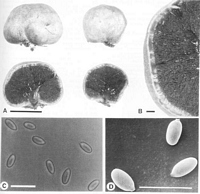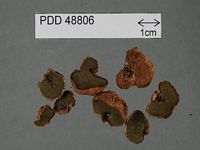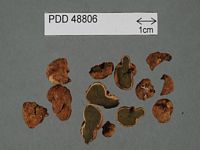|
 Protubera nothofagi Protubera nothofagi
BiostatusPresent in region - Indigenous. Endemic
Images (click to enlarge)
Caption: Fig. 11 Protubera nothofagi. A, Basidiomata exterior and in section (PDD 48806). B, Detail
of peridial wall in section (PDD 48806). C, Basidiospores by bright field (PDD 48806). D,
Basidiospores by SEM (PDD 48806). Scale: 1 cm (A), 1 mm (B), 10 | 
Caption: Dried type specimen
Owner: Herb PDD | 
Caption: Dried type specimen
Owner: Herb PDD |
Article: Castellano, M.A.; Beever, R.E. (1994). Truffle-like Basidiomycotina of New Zealand: Gallacea, Hysterangium, Phallobata, and Protubera. New Zealand Journal of Botany 32(3): 305-328 (http://www.rsnz.org/publish/abstracts.php).
Description: Basidiomata up to 3 cm diam., globose to depressed, larger sporocarps somewhat
irregular, surface white to pale yellow, when fresh, pale pink to brown when bruised, pale
greyish yellow brown to pale yellow brown when dried, glabrous Gleba gelatinous, dark
greyish olive to yellow brown to olive black when deliquescent; locules elongate, more or
less radially arranged, partially filled. Rhizomorph evanescent, single, stout concolorous
with peridium. Columella dendroid, up to 6 primary branches in longitudinal section,
gelatinous, translucent to white near attachment point, translucent brown when dried.
Taste nil to slightly peppery. Odour nil to sharply putrid when gleba deliquescent.
Peridium 2-layered, c. 1 mm thick, epicutis readily peeling from subcutis; epicutis 250-
300(-350) µm thick, of thin-walled, compact, irregularly shaped, subpericlinal to
interwoven hyphae, 5-8 µm diam., occasionally inflated to 12.5(-25) µm diam., outer 10-20 µm golden brown,
inner portion hyaline, clamp connections absent; subcutis c. 800
µm thick, of hyaline, irregularly shaped, compact, interwoven hyphae, c. 5 µm diam., in a
gelatinised matrix, clamp connections absent. Sutures transecting subcutis, common,
structurally similar to, and continuous with, the inner portion of the epicutis and trama.
Trama of hyaline, thin-walled, compact, interwoven hyphae, c. 5 µm diam., in a
gelatinised matrix of different texture to that of peridial subcutis clamp connections
absent. Basidia hyaline, thin-walled, elongate to mostly napiform, 20-23 x 4-9 µm,
broader at base than apex, 6-8-spored. Spores smooth, 6-7 x 3-3.5 µm, ellipsoid, apex
obtuse, base with a short sterigmal attachment to sessile; wall <0.5 µm thick. Utricle
absent. Spore colour in KOH pale green singly, pale olive green in mass.
Habitat: Habitat: hypogeous in Nothofagus forest, putatively mycorrhizal with Nothofagus fusca,
N. menziesii, N. solandri, and N. solandri var. cliffortioides. Season: December through
May.
Distribution: New Zealand.
Notes: ETYMOLOGY: Referring to the association of this fungus with Nothofagus.
REMARKS: Protubera nothofagi differs from other Protubera species in its larger
spores, separable epicutis, and strict association with Nothofagus spp.
Article: Gadgil, P.D. (in association with Dick, M.A.; Hood, I.A.; Pennycook, S.R.) (2005). Fungi on trees and shrubs in New Zealand. Fungi of New Zealand. Ngā Harore o Aotearoa 4: xi + 437 p. Hong Kong: Fungal Diversity Press.
Description: Type: Mycorrhizal Fungi; Description: Basidiomata hypogeous, globose to depressed globose, white to pale yellowish pink, pink to brown when bruised, up to 30 mm in diameter, with a single evanescent rhizomorph; peridium composed of two layers, golden brown in section. Gleba dark greyish olive to olive black; locules elongate, more or less radially arranged, partially filled with basidiospores, gelatinous, deliquescing later; tramal plates consisting of interwoven hyaline hyphae; columella branched. Basidiospores elliptical, 0-septate, 6–7 × 3–4 μm, smooth, pale green; utricle absent.
Distribution: Distribution: Taupo, Nelson, Buller, Fiordland, North Canterbury.; 1st Record: Chu-Chou & Grace (1983b: as Hysterangium sp. 4, pro parte).
|